I stepped into Hoi An and was hit with two things at once: the glow of lanterns strung across every street and the crush of people packed shoulder to shoulder. The town is beautiful in that old, faded kind of way – yellow walls chipped just enough to feel real, but the chaos is hard to ignore. Street vendors shout over one another, boats jostle for attention on the Hoai River, and somewhere between the incense smoke and the scent of sizzling skewers, it hits you: this festival isn’t just about floating lanterns. It’s about watching a place bend under the weight of its own hype.
I was based in Da Nang at the time – easy enough to make a day trip out of it. A few friends and I grabbed a ride down, drawn by the promise of magic. And sure, it was photogenic. But as we floated a candlelit lantern into the murky water, I couldn’t help but wonder where it would end up—or if this ritual meant much anymore.
If you’re already headed to central Vietnam, Hoi An is worth a stop. But should you rearrange your itinerary just to see the Lantern Festival? That’s where things get complicated.
The Origins of Hoi An Lantern Festival
Long before the tour groups and the selfie sticks, Hoi An was a bustling trading port. Back in the 16th century, Chinese and Japanese merchants set up shop here, bringing with them the tradition of hanging lanterns outside their homes—symbols of luck, protection, and connection to the places they’d left behind.
Over time, that tradition wove itself into Vietnamese lunar rituals, especially the monthly full moon, known locally as “moon day.” It became a time for ancestral offerings, quiet reflection, and small acts of devotion. The lanterns stuck around—not just as decoration, but as a kind of cultural anchor.
These days, they’re everywhere. And while the modern festival leans more spectacle than stillness, its roots run deep. At its best, the lantern festival is a blend of spiritual intention and everyday celebration—a moment where the past flickers alongside the present, lit by candlelight and wrapped in paper.
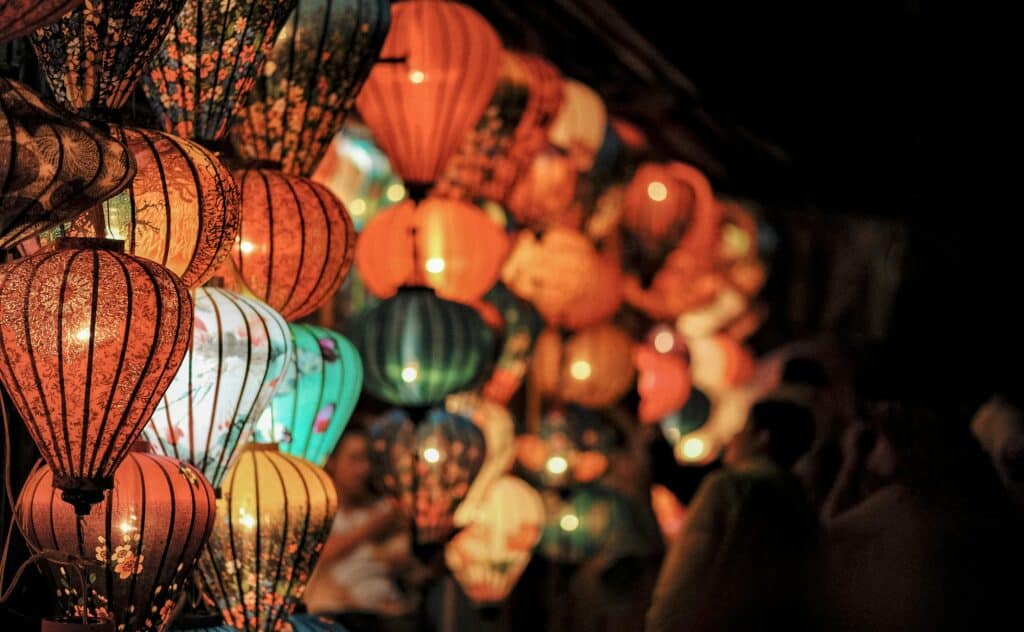
What Is the Hoi An Lantern Festival—and When Does It Happen?
What Is the Hoi An Lantern Festival—and When Does It Happen?
Despite how it’s marketed, the Hoi An Lantern Festival isn’t a once-a-year spectacle, it’s a monthly event. Every 14th night of the lunar calendar, the town flips the switch on its electric lights and leans into its full moon traditions. It’s the kind of ritual that’s been reshaped by time, tourism, and logistics, but it still happens – every single month.
The most crowded and “extra” version takes place in February, during the first full moon of the Lunar New Year. That’s when the crowds peak, the performances multiply, and the festival stretches to its most theatrical form. If you’re after atmosphere without chaos, consider any full moon between March and August instead.
The evening officially starts around 6PM, but things get truly photogenic once the sky goes dark and the lanterns take over. By 10PM, the crowds thin and the glow dims.
Bottom line? You don’t have to plan your whole Vietnam trip around this one night – though if it lines up, it’s worth checking out. Just manage your expectations accordingly.
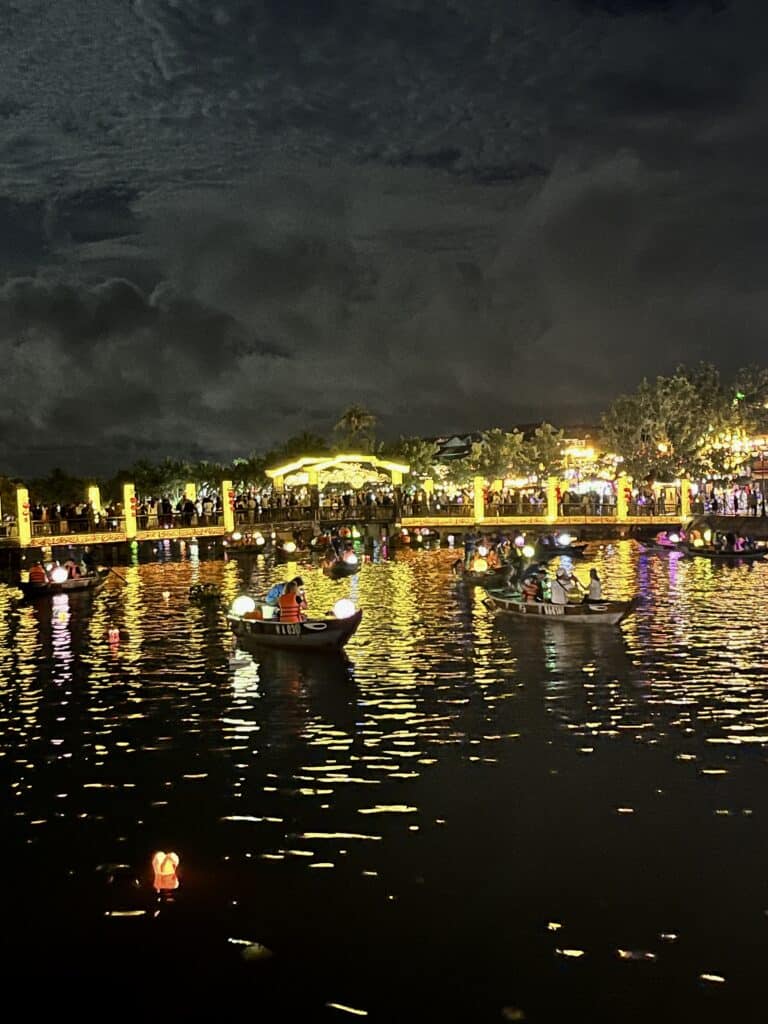
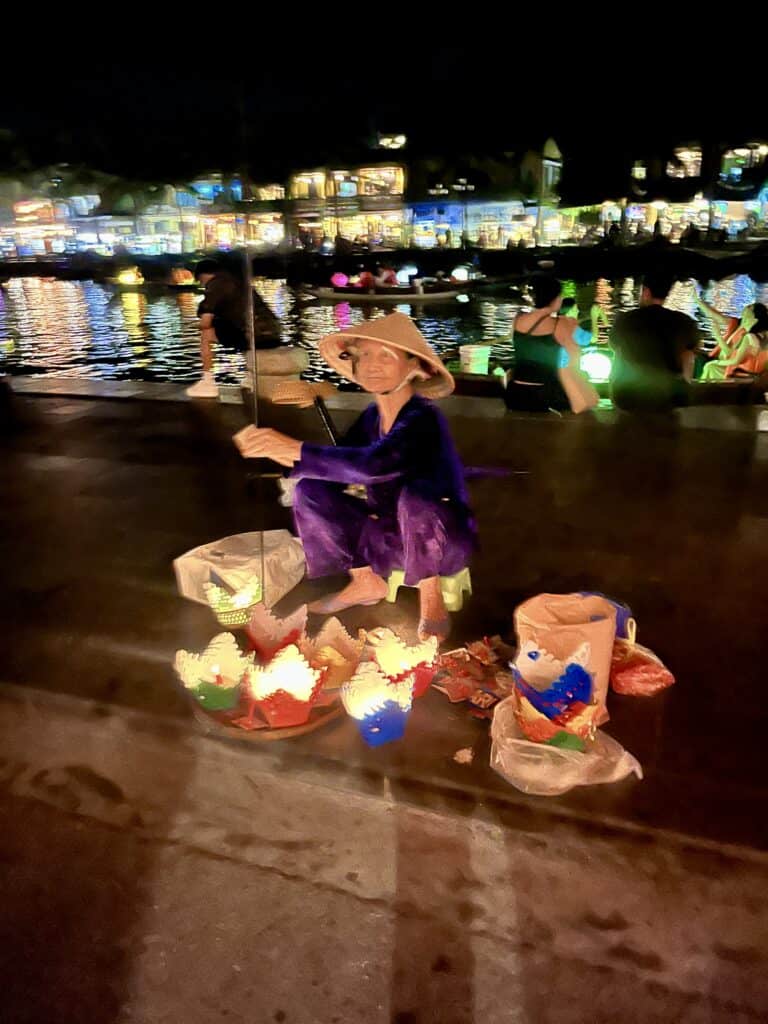
My Unfiltered Take from 2024
I’d seen the pictures—soft-lit boats drifting down a mirror-still river, lanterns glowing like magic—but walking into the festival felt more like stepping into a concert crowd. Beautiful, yes. But also loud, messy, and a little overwhelming.
I came down from Da Nang with friends, hoping for something meaningful. What I got was more of a photo op. Boatmen called out from every direction. The river was murky. We floated a lantern, snapped a few pictures, and that was it. You’re told it’s a spiritual experience, but it felt more scripted than sacred.
Still, the town has its moments. The lanterns strung overhead are genuinely lovely, the food carts are chaotic in the best way, and if you duck into a quiet side street, you’ll catch a glimpse of something softer—Hoi An as it might’ve been before the festival became a brand.
If you’re already headed to Hoi An, the festival is worth witnessing once. But if you’re planning your whole Vietnam trip around it, I’d temper the hype. Some of the country’s most compelling moments come from the unexpected—the places without performance. Like train tracks cutting through daily life in Hanoi, or limestone cliffs rising up around rice paddies in Ninh Binh. The lanterns? They’re beautiful. But they’re not everything.
But—What Do You Actually Get Out of It?
There’s no denying it: the festival is photogenic as hell. If what you’re after is that iconic shot—paper lantern in hand, river glowing behind you—you’ll get it. The setting is cinematic. The colors, reflections, and chaos all play well on camera.
You’ll also get a front-row seat to Vietnam’s talent for weaving tradition into tourism. Lanterns here aren’t just props—they’re handmade by local artisans, many of whom still pass down techniques from generation to generation. And on moon nights, you might stumble across traditional folk games, live music, or a grandmother quietly lighting incense outside her door. These moments aren’t curated—they just happen, if you’re lucky enough to notice.
But you’ll also get crowds. Noise. A boat ride that feels more transactional than transcendent. The lantern release, while pretty, might leave you wondering what happens to all those bits of wax and paper in the river. It’s a festival caught in between worlds: part ritual, part revenue stream.
So what do you really get? A glimpse of something real, tucked inside something packaged. If you know that going in, you’ll appreciate it for what it is—not what it’s trying to be.
Practical Tips for Travelers
Plan Ahead: While the festival is held every full moon, the biggest celebrations are during the first full moon of the Lunar New Year. February is ideal if you’re after the most lanterns, performances, and food stalls, but visiting from March to August gives you a quieter experience without missing out on the charm.
Arrive Early: Hoi An is compact, and the festival draws quite the crowd. Arrive in the morning to wander the charming streets of old town and enjoy a peaceful start, with lanterns softly glowing from the previous night’s celebration.
Avoid the Crowds: If crowds aren’t your thing, try exploring the quieter side streets where some of the best lantern displays are tucked away from the busiest paths.
Embrace the Crowds: That said, the energy is part of the festival’s charm. Dive into the bustling night market, sample delicious street food, and soak up the atmosphere—it’s all part of the experience!
Wear Comfortable Shoes: Trust me, you’ll be doing a lot of walking, and Hoi An’s cobblestone streets aren’t exactly foot-friendly after a few hours.
Support Local Artisans: While mass-produced lanterns are cheaper, handmade ones crafted by local artisans are worth every penny. Plus, you’re supporting the people who keep this tradition alive.
Take a Lantern-Making Workshop: For a hands-on experience, join a lantern workshop. You’ll craft a piece of Hoi An’s culture and take home a souvenir that you made yourself.
Don’t Forget a Camera (and a Power Bank!): You’ll want to capture these magical moments. Make sure your camera or phone is charged—this is one experience you’ll definitely want to remember.
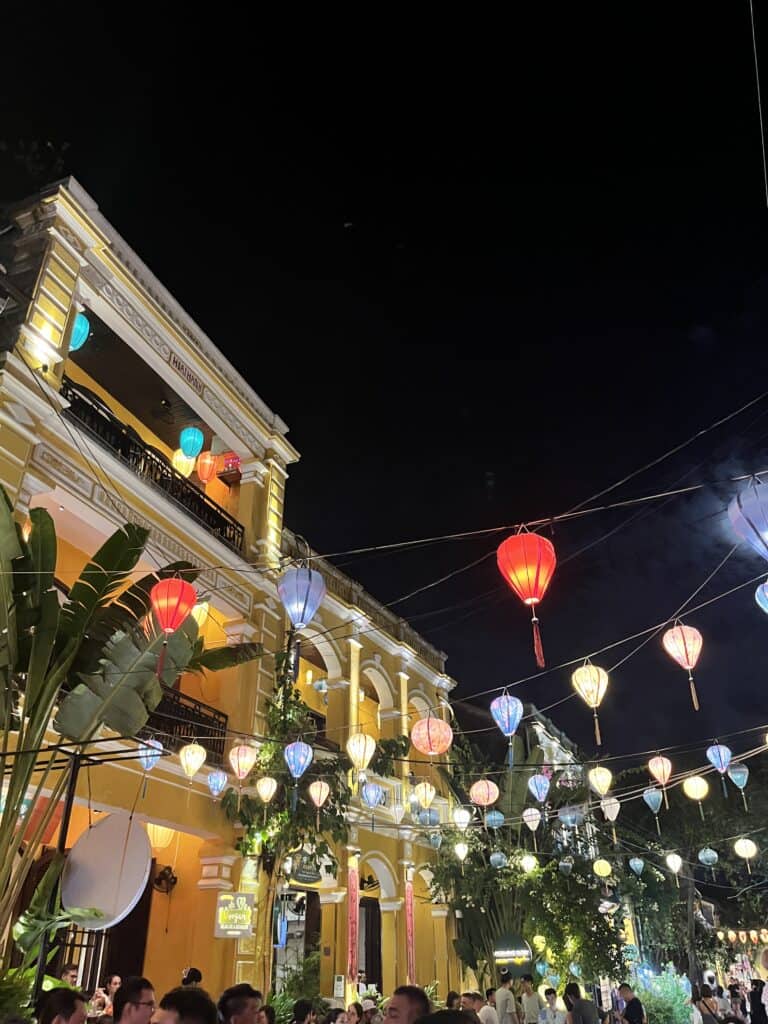
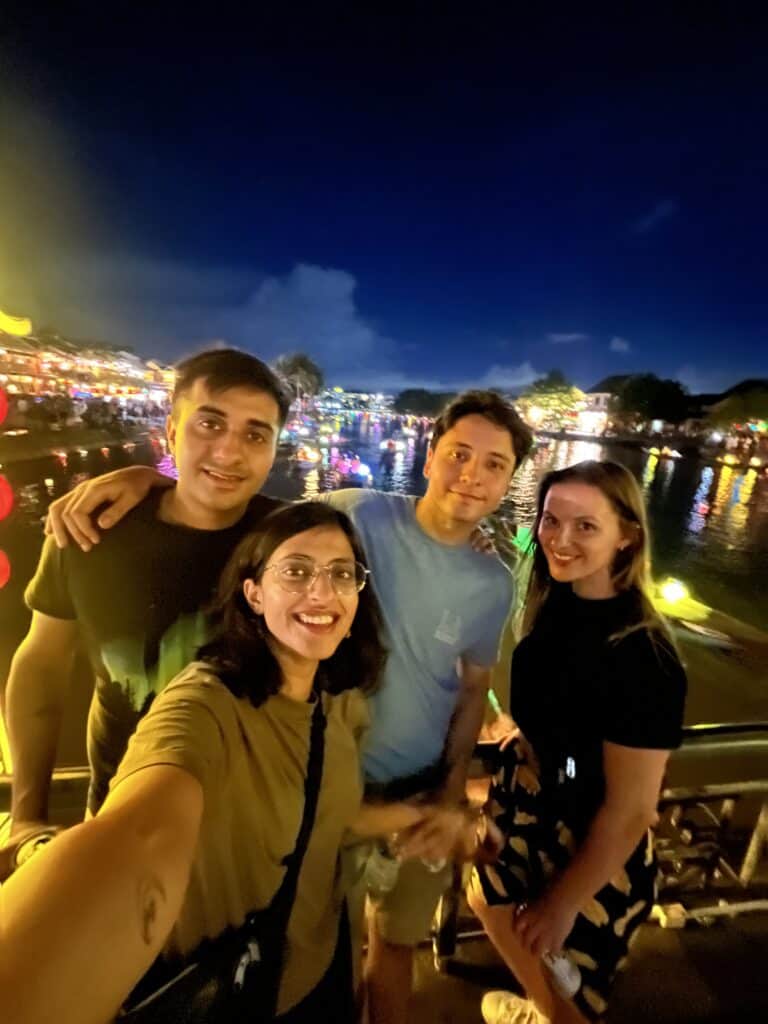
Is the Festival Worth It?
I happened to be in Da Nang for a while, so I shifted my plans to attend the lantern festival in Hoi An. And while I’m glad I did, I’ve heard from many that Hoi An holds that same charm on any evening. So, while I’d absolutely recommend visiting Hoi An, don’t feel pressured to rearrange your travel dates just for the festival—it’s beautiful but not essential for experiencing the town’s magic.
In your broad Vietnam Itinerary, I do think this ranks lower than both Hanoi and Ninh Binh. So if you’re pressed on time – I’d suggest skipping it.
The Downsides to Consider
I loved the festive atmosphere, but it’s hard not to wonder—what happens to all those lanterns floating down the river? Are we adding to pollution, or is this tradition more sustainable than it seems? And then there’s the commercial side of it: with more tourists every year, Hoi An’s once-quiet streets now overflow with visitors, cameras, and selfie sticks. I don’t mean to get all philosophical, but it does make you think about the impact.
One local shop owner told me, “We’re proud people come to see Hoi An Ancient Town beauty, but sometimes, we miss the quieter full moon nights.” Yet, the cultural essence of the festival is still there, beneath the layers of modernization. Hoi An has a way of adapting, finding that balance between preserving its heritage and evolving with the times—it’s part of what makes this place so interesting.
Hoi An Lantern Festival Dates 2024 and 2025
| Year | Date |
|---|---|
| 2024 | 14 November |
| 2024 | 14 December |
| 2025 | 13 January |
| 2025 | 11 February (largest celebration, first full moon of the lunar new year) |
| 2025 | 13 March |
| 2025 | 11 April |
| 2025 | 11 May |
| 2025 | 9 June |
| 2025 | 8 July |
| 2025 | 7 August |
| 2025 | 5 September |
| 2025 | 5 October |
| 2025 | 3 November |
| 2025 | 3 December |
How to Get to Hoi An
Hoi An is well-connected, especially for travelers coming from nearby cities. The closest airport and train station are in Da Nang, which is only an hour away. Buses are the most budget-friendly and convenient option, and you’ll find routes from major cities like Da Nang, Hue, Quy Nhon, and even Nha Trang.
If you’re traveling from Hue, consider taking a motorbike transfer along the Hai Van Pass—a route famous for its scenic views and sweeping ocean vistas. This option lets you enjoy the journey itself, not just the destination.
Here’s a quick breakdown of some travel times and costs:
From Da Nang: ~1 hr, 110,000 VND, you can also get a Grab taxi from Danang that will cost around 250,000 VND.
From Hue: ~3.5 hrs, 150,000 – 250,000 VND
From Nha Trang: 10+ hrs (overnight sleeper bus), ~300,000 VND
From Quy Nhon: ~6 hrs, ~200,000 VND (book in Vietnam via a travel agent or hostel)
Best Time to Visit
The best time to visit Hoi An is between February and April, when the weather is mild and dry. February’s Lantern Festival, during the first full moon of the lunar new year, is the festival’s biggest celebration. If you prefer fewer crowds, aim for any other full moon night between March and August.
Day Trip from Da Nang
I did a day trip to Hoi An from Da Nang, where I was based, and it worked out well. While Hoi An deserves more than just a day, this option lets you experience the town’s charm if you’re short on time. You’ll still get a feel for Hoi An’s lantern-lit streets and unique atmosphere before returning to Da Nang.
So—Is It Worth It? Final Verdict
Yes. And also, not really.
If you’re already in Hoi An, or passing through central Vietnam, the Lantern Festival is worth seeing once. It’s beautiful in moments, chaotic in others, and ultimately more about the spectacle than the soul.
But don’t rearrange your entire Vietnam itinerary just to catch it. Hoi An holds its charm on regular nights, too—when the crowds are smaller, the light softer, and the town feels a bit more itself.
If you want lanterns, you’ll get them. But if you’re chasing something quieter, something that still feels unfiltered—consider trading the boat ride for an early morning market run, or swapping a festival night for a hike through Ninh Binh’s limestone cliffs or a lazy day on the Da Nang beaches.
The magic in Vietnam isn’t always where the internet says it’ll be. Sometimes it’s in the detours.
Frequently Asked Questions
What time is the Lantern Festival in Hoi An?
It kicks off around 6PM, when the town shuts off its electric lights and the lanterns begin to glow. Things wind down by about 10PM. If you want dinner before the crowds hit, get there by sunset.
Are the lanterns in Hoi An every night?
Not quite. Lanterns are up most nights because Hoi An banks on them year-round, but the actual festival happens once a month, on the 14th night of the lunar calendar—a traditional full moon celebration. That’s when the street lights go off, performances pop up, and the town leans into the whole vibe.
How much do lanterns cost in Hoi An?
If you’re floating one on the river, you’ll pay 10,000–20,000 VND (~$0.40–$0.80). Want one to take home? Expect 40,000–100,000 VND depending on size and quality. Bargain politely, but remember someone hand-crafted that thing.
Where can I buy lanterns?
You’ll find vendors all along the riverfront and at the Night Market on Nguyen Hoang Street. If you want something sturdier than a candle-in-a-cup, head to Hong Van Handmade Lanterns or take a lantern-making workshop. At least that way, you’ll leave with something useful—not just another dusty souvenir.
